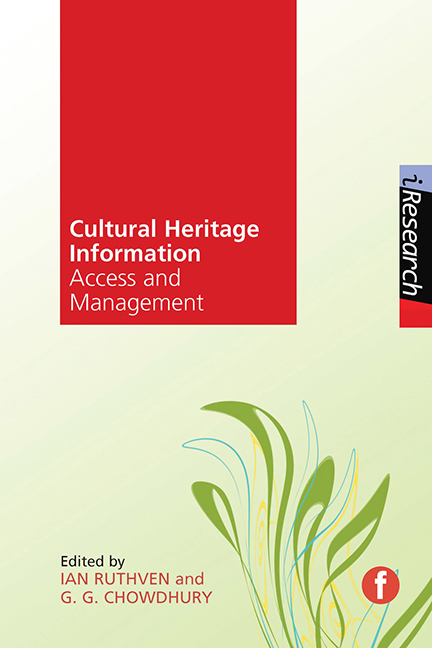Book contents
- Frontmatter
- Contents
- List of figures and tables
- Contributors
- Preface
- 1 Managing digital cultural heritage information
- 2 Digital humanities and digital cultural heritage (alt-history and future directions)
- 3 Management of cultural heritage information: policies and practices
- 4 Cultural heritage information: artefacts and digitization technologies
- 5 Metadata in cultural contexts – from manga to digital archives in a linked open data environment
- 6 Managing cultural heritage: information systems architecture
- 7 Cultural heritage information: users and usability
- 8 A framework for classifying and comparing interactions in culturalheritage information systems
- 9 Semantic access and exploration in cultural heritage digital libraries
- 10 Supporting exploration and use of digital cultural heritage materials: the PATHS perspective
- 11 Cultural heritage information services: sustainability issues
- Index
4 - Cultural heritage information: artefacts and digitization technologies
Published online by Cambridge University Press: 10 September 2022
- Frontmatter
- Contents
- List of figures and tables
- Contributors
- Preface
- 1 Managing digital cultural heritage information
- 2 Digital humanities and digital cultural heritage (alt-history and future directions)
- 3 Management of cultural heritage information: policies and practices
- 4 Cultural heritage information: artefacts and digitization technologies
- 5 Metadata in cultural contexts – from manga to digital archives in a linked open data environment
- 6 Managing cultural heritage: information systems architecture
- 7 Cultural heritage information: users and usability
- 8 A framework for classifying and comparing interactions in culturalheritage information systems
- 9 Semantic access and exploration in cultural heritage digital libraries
- 10 Supporting exploration and use of digital cultural heritage materials: the PATHS perspective
- 11 Cultural heritage information services: sustainability issues
- Index
Summary
Introduction
Since the 1970s, the gallery, library, archive and museum sector has promoted and encouraged digitization – the conversion of analogue into digital information – to increase access to cultural heritage material through various incarnations of digital media. Indeed, it is now expected by both users and professionals that institutions should be undertaking digitization programmes, and best practices in this area are now well documented and understood. This chapter scopes out the background to the current digitization environment, giving an overview of the methods and approaches involved. It points to current developments, highlighting the use of both two- and three-dimensional capture methods for the creation of digital surrogates of objects and artefacts, indicating the potential for further development in the sector, whilst drawing attention to current issues faced when digitizing objects and artefacts, including cost, sustainability, impact evaluation and expectation management in the changing information environment. The affordances of previously prohibitively expensive techniques – such as multi-spectral imaging and 3D scanning – are now available at relatively inexpensive rates, which also raises questions about digital literacy and our understanding of what it means, for both the end-user and the information professional, to create digital versions of our cultural inheritance.
Digitization of cultural and heritage content
Digitization, ‘the conversion of an analog signal or code into a digital signal or code’ (Lee, 2002, 3), is now commonplace across the heritage sector, as digital representations of cultural and historical documents, artefacts and images are created, usually for putting into institutional repositories and for featuring on websites, encouraging remote viewing by online users. Digitization may appear to be a recent phenomenon in memory institutes, but the current state of affairs where libraries, archives, museums, galleries and even private individuals are expected to make available their collections in digital form follows a period of experimentation with and appropriation of available digital technologies which dates back almost 40 years (see Terras, 2010, for a fuller account of the history of digitization). The information, culture and heritage sectors were quick to embrace digitization technologies as they became available, primarily to facilitate access to items in collections by providing them in electronic format, firstly with the creation of electronic catalogues in the 1970s, then conversion of printed source material into digital files in the 1980s (Van Horick, 2005).
- Type
- Chapter
- Information
- Cultural Heritage InformationAccess and Management, pp. 63 - 88Publisher: FacetPrint publication year: 2015
- 11
- Cited by



